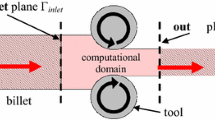Abstract
Remeshing is an important problem encountered often in the FEM-simulation of metal forming processes. This paper describes the remeshing scheme developed at LAMI and IBF for the FINEL FEM-program. A novel automatic, two-dimensional, quadrilateral mesh generator is introduced. Mesh generation is performed by means of image processing and computational geometry. Other features of the remeshing scheme are boundary simplification, smoothing, and rezoning. Examples of applications are given.
Similar content being viewed by others
References
M.L. Cho (1987) Bewertung der Anwendbarkeit der FEM fuer die Umformtechnik, Verlag Stahleisen
R. Kopp, M. Becker (1990) A concept for dynamic Remeshing at FEM-simulation shaved by the example of the forging process, ICTP 90, Kyoto, Japan
P. Brooks (1987) Verifying finite element results; a graphical approach. J. Eng. Comp. Appli., 19–27
P.L. Baehmann, M.S. Shephard, R.A. Ashley, A. Jay (1988) Automated metal forming analysis utilizing adaptive remeshing and evolving geometry, Comp. Struc. 30, 319–326
P.L. Baehmann, S.L. Wittchen, M.S. Shephard, K.R. Grice, M.A. Yerry (1987) Robust, geometrically based, automatic two dimensional mesh generation, Int. J. Num. Meth. Eng. 24, 1043–1078
A.M. Habraken, J.P. Radu (1989) Simulation of forging applications with the finite element method. NUMIFORM 89, Thompson et al. (eds.), 543 ff.
L.J. Hageman (1987) Automatic adaptive remeshing in EALPID, an advanced forging simulation program, Comp. Eng.
A.J.G. Schoofs, L.H.Th.M. von Beukering, M.C. de Sluiter (1979) TRIQUAMESH: A general purpose two dimensional mesh generator. Adv. Eng. Software 1 (3)
W.T. Wu, S.I. Oh, T. Altan, R.A. Miller (1990) Automated mesh generation for forming simulation—I, Proc. ASME Int. Comp. Eng. Conf., Boston
J.H. Cheng (1988) Automatic adaptive remeshing for finite element simulation of forming processes, Int. Jou. Num. Meth. Eng. 26, 1–18
K. Ho-Le (1988) Finite element mesh generation methods: A review and classification. Comp. Aid. Des. 20, No. 1
J.A. Talbert, A.R. Parkinson (1990) Development of an automatic two dimensional finite element mesh generator using quadrilateral elements and Bézier curve boundary definition. Int. Jou. Num. Meth. Eng. 29, 1551–1567
E.A. Heighway (1983) A mesh generator for automatically subdividing irregular polygons into quadrilaterals, IEEE Trans. Magn. MAG-19, No. 6, 2535 ff.
W. Oberschelp, M. Bierwagen (1991) Mathematische Methoden der Bildcodierung und Computergrafik, Internal report RWTH
D. Hearn, M.P. Baker (1986) Computer Graphics. Prentice Hall, Englewood Cliffs, NJ
T. Pavlidis (1982) Algorithms for Graphics and Image Processing, Computer Science Press
R. Schneiders (1989) Generierung von zulässigen Vierecksnetzen für die FEM-Methode, Lehrstuhl für angewandte Mathematik insb. Informatik
U. Strieder (1989) Entwicklung von Kriterien zur Messung der geometrischen Entartung von 2-dimensionalen FEM-Netzen aus 4-Knoten-Elementen, Int. Report IBF, Aachen
K. Lange, W. Osen (1985) Cold extrusion processes combined with radial extrusion. Man. Eng. Transactions
Comm. ACM, Vol. 2.4, Algorithm 508
M. Becker (to appear) Anwendung von höheren Optimierungsmethoden in der Umformtechnik, Ph.D. thesis
Author information
Authors and Affiliations
Additional information
R. Schneiders and M. Becker were supported by the Deutsche Forschungsgemeinschaft under grant no. KO579/31-1.
Rights and permissions
About this article
Cite this article
Schneiders, R., Oberschelp, W., Kopp, R. et al. New and effective remeshing scheme for the simulation of metal forming processes. Engineering with Computers 8, 163–176 (1992). https://doi.org/10.1007/BF01200367
Issue Date:
DOI: https://doi.org/10.1007/BF01200367




